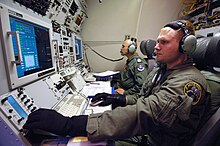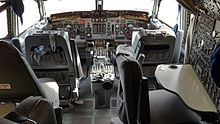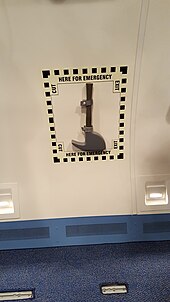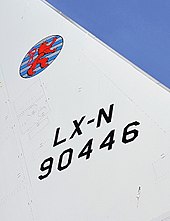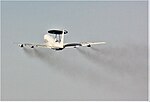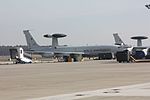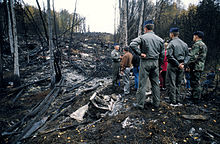Boeing E-3
| Boeing E-3 Sentry | |
|---|---|
 A USAF E-3 "Sentry" |
|
| Type: | AWACS - aerial reconnaissance |
| Design country: | |
| Manufacturer: | |
| First flight: |
October 1975 |
| Commissioning: |
March 1977 |
| Production time: |
1974 to 1991 |
| Number of pieces: |
68 |
Boeing E-3 Sentry is the military name for a variant of the Boeing 707-320, which is used as an Airborne Warning and Control System by the air forces of several countries. Your task includes the reconnaissance of enemy aircraft and the command of your own aircraft. The most noticeable external feature is the AN / APY-1 search radar above the fuselage.
history
development
During the 1960s, the US Air Force was looking for a successor to the EC-121 "Warning Star" as part of a program to develop new technologies for an airborne surveillance system, on whose radar system both Hughes and Westinghouse were working. A jet aircraft was planned as the carrier; Douglas suggested the DC- 8-60 and Boeing the 707-320B as a base . The latter was selected with four TF33 engines in July 1970, with the two prototypes being equipped with four TF33 (JT3D) engines for the comparison test of the two radar systems for reasons of time. The first flight of the two machines designated as EC-137D took place on February 9 and 10, 1972 and the following flight test lasted until September 1972, from which the Westinghouse AN / APY-1 radar emerged as the winner. The official development of the new AWACS system that followed from January 1973 was called E-3A Sentry. The first flight of the first pre-production model took place on July 21, 1975 and it was decided that the production model should only be equipped with four engines. In March 1977, the 552nd Airborne Warning and Control Wing in Tinker AFB (Oklahoma) began to be equipped with the 22 series machines (referred to as the “core” standard) as well as the two prototypes and the two pre-series machines. In the first half of the 1980s, eight more machines in an improved "standard" version with AN / APY-2 radar were put into service.
Introduction to NATO
At the ministerial meeting of the NATO Defense Planning Committee on December 5 and 6, 1978 in Brussels , the ministers approved the program for the NATO airborne early warning and guidance system and signed a corresponding multilateral agreement in principle. With the Airborne Warning and Control System (AWACS), the member states launched the largest jointly financed procurement program that was carried out by NATO up to that point.
At the beginning of the 1970s, the NATO Supreme Commanders commissioned studies that showed that the existing permanently installed systems no longer guarantee an effective air defense in the continental European area: The Warsaw Pact already had fast aircraft that were able to For example, to evade long-range radars when flying low ; there was still the danger that the permanently stationed systems could be switched off by electronic warfare (Eloka), and the pre-warning time was limited to about half an hour depending on the location. In the NATO command area of SACEUR , for example, mobile systems were expected to provide the ability to detect even smaller attack groups at an early stage and to deploy their own interceptors with radar support.

The first E-3A machines, also known as NE-3A (N for NATO), came into service at the NATO Air Base in Geilenkirchen from February 24, 1982 , previously in the USA since March 1977. The aircraft for NATO were equipped at the Dornier works in Oberpfaffenhofen and later also looked after. Today the technical support of the NATO aircraft takes place in the Manching plant of the Airbus Group. An ESM system has also been retrofitted here in recent years , recognizable by the two antenna bulges on the left and right of the front fuselage.
The contract for the operation of the AWACS lies with the NATO Airborne Early Warning and Control Program Management Organization (NAPMO), which is responsible for the planning, implementation and administration of the NATO Airborne Early Warning and Control Program (NAEW & C ) responsible for. It reports directly to the North Atlantic Council based at NATO headquarters in Brussels (SHAPE).
The systems are used by various NATO countries and NATO itself. The 17 NATO-owned aircraft have Luxembourg aircraft registration numbers and are stationed at Geilenkirchen Air Base near Aachen . The RAF flies from RAF Waddington on behalf of NATO . France has its machines stationed in Avord . In addition, until the end of 2011 there were still three training machines without antenna, so-called TCA (Trainer and Cargo Aircraft), at the base in Geilenkirchen . During the Cold War, the system served as an early warning of low-flying Warsaw Pact aircraft .
modernization
Mid-term program
The 17 E-3As of the NATO Airborne Early Warning & Control Force were modernized by Boeing (prime contractor) and EADS as part of the NATO mid-term program for $ 1.6 billion. The computer system for processing the data recorded by the radar was completely replaced by a COTS computer and a Unix- based server-client network. On December 2, 2008, the 17th and last machine had been converted and was officially taken over during a ceremony in Geilenkirchen.
Cockpit upgrade
In August 2014 it was announced that Boeing will modernize the avionics in the cockpits of the NATO AWACS fleet for around 250 million euros. The program began at the end of 2014, and at the end of 2015 the first aircraft modified in this way landed in Geilenkirchen again. From 2016 to 2018, a further 13 aircraft are to be converted, so that 14 of the 18 NATO E-3s will receive the upgrade.
Engines
Due to the outdated propulsion technology, some of the NATO AWACS planes fly with a special permit, as the E-3A's engines no longer meet the modern environmental requirements with regard to noise pollution and exhaust emissions. The British (E-3D) and French versions (E-3F) were, however, equipped with more modern engines. These concepts are currently also being examined by NATO's E-3A; an implementation has so far failed time and again due to resistance from individual nations that did not want to pay any money for this technology. All decisions regarding the NAEW-NATO-E-3A components can only be implemented with unanimity.
US AWACS fleet
The B and C versions of the US Air Force will receive new communication and electronic equipment based on NATO Mid-Term in the so-called Block 40/45 in the next few years and will then be referred to as E-3G . So far, nine out of 24 machines have been converted.
successor
Since the basic model Boeing 707 and its variants have not been produced since the beginning of the 1990s, the US Air Force and other interested parties such as Japan have been using the Boeing E-767 as a reconnaissance platform. The successor model E-10 planned for the USAF was stopped for the time being due to cost reasons. Therefore, the United States Air Force (USAF) plans to keep some of the 33 machines in service until after 2025.
NATO Secretary General Jens Stoltenberg announced in November 2019 that the defense alliance's fleet would be modified again so that it would remain operational until 2035. The contract is worth $ 1 billion.
Versions
The standard version of the Sentry is officially called E-3A "Core" or "Standard". Most of the US Air Force machines were modernized in the 1980s and designated as E-3B (Block 20). In addition to the new AN / APY-2 radar, these included CC2 computers, new radios and now 14 control consoles. From 1987 further modernized machines corresponded to the Block 30 standard. In the course of further modernization many of the new aircraft received CFM - engines and the designation E-3C (block 25 and block 35). In the late 1980s, Boeing and British Aerospace developed a modernized version of the Sentry for the Royal Air Force of Great Britain , the E-3D Sentry AEW Mk.1. This received (like the E-3A machines for Saudi Arabia) the more powerful CFM International CFM56 engines as well as a device for air refueling , with which the Sentry can be refueled by both American and European tanker planes, as these use different systems . In addition, the range of applications has been expanded. Eight E-3A were upgraded to the E-3C standard. In parallel to the E-3D, the E-3F was developed for France , which differs from this only in a few details. The latest variants (from 2008) are the Block 40/45 models, which contain modernized computer and data link systems.
Variant overview
- EC-137D
- Name of the two AWACS prototypes with JT3D engines. One prototype was equipped with the Westinghouse radar, the other with a Hughes model. Both machines were later converted to E-3As with TF33 engines.
- E-3A
- First production version of the Sentry, with TF33 engines and AN / APY-1 radar. 24 machines were built for the USAF, 18 received by NATO. In addition, five machines with CFM56 engines were built for Saudi Arabia.
- KE-3A
- Name for a series of eight tanker aircraft for Saudi Arabia based on the E-3A.
- E-3B
- Modernized E-3A version with the AN / APY-2 radar. The USAF had all of its 24 E-3A machines converted to this so-called Block 20 standard.
- E-3C
- Production version with the AN / APY-2 radar, additional consoles and improved systems. 10 machines were built for the USAF (also called Block 30).
- JE-3C
- Name for a converted E-3A that was used by Boeing for test purposes.
- E-3D
- Variant of the E-3C for the Royal Air Force. Has some modifications, including a. the CFM56 engines. The seven machines built are also referred to as Sentry AEW.1.
- E-3F
- Variant of the E-3C for the French Air Force, which also uses the CFM56 engines. Four machines were built. All E-3F machines will receive a "mid-life update" between 2014 and 2016
- E-3G
- USAF designation for the 40/45 block modernization. The USAF is currently having 24 E-3 machines converted to this new standard.
Radar system
The approximately 3.6 tonne AN / APY-1 search radar dominates the silhouette of the E-3. It is housed in a large radome 3.35 m above the fuselage, which has a diameter of 9.1 meters and a thickness of up to 1.8 meters. The system can detect and track air targets of all kinds (including combat aircraft , helicopters and cruise missiles ), even if they fly very low ( low-altitude flight ) or have only a small radar cross-section . The reconnaissance of ships at sea has also been fully integrated since the introduction of the APY-2 variant. The antenna is mechanically aligned in azimuth by rotation and electronically in elevation (28 ferrite - based phased array antennas ).
Technical specifications
- Diameter: 9.14 m
- Height: up to 1.8 m
- Weight: 3629 kg
- Frequency range : 2-4 GHz
- Number of transmitters : 28
- Antenna rotation time: 10 s
- Range: over 460 km (up to 400 km for low-flying targets, up to 520 km for targets at medium altitudes)
RSIP upgrade
The RSIP upgrade ("Radar System Improvement Program") represents a comprehensive increase in the combat value of the APY-1/2 radar. The range resolution could be increased by six times and the angular resolution by twice. The ECCM capacities have also been significantly expanded. In addition, improvements in operability and reliability have been made. The detection range has been increased by 70–100% and should be at least 300 nm (556 km) against a target with a radar cross-section of 0.5 m².
Operating modes
The radar has several operating modes that can be selected depending on the situation. The following are the most important modes that have been available since the RSIP upgrade.
- Pulse Doppler Nonelevation Scan (PDNES): This is the standard mode for acquiring aerial targets. Thanks to the Doppler filter, even small targets can be reliably detected against the background of intense clutter . However, this mode does not provide any altitude information about the destination.
- Pulse Doppler Elevation Scan (PDES): Similar to PDNES mode, but enables elevation to be determined using a quick vertical search pass.
- Beyond-the-Horizon (BTH): This mode is used to achieve very high ranges. This is achieved by switching off the Doppler filter. However, it is now hardly possible to capture targets in a clutter environment. Therefore, in this mode only the airspace is searched which is above the visible horizon of the radar.
- Interleaved : Combines the PDES and BTH mode, whereby the signal processing is heavily used so that very small targets may no longer be reliably located.
- Maritime : Mode for searching for large and small sea targets. For this purpose, the pulse length (transmission time) is greatly reduced in order to suppress clutter caused by waves as well as possible. In coastal areas, the mainland is automatically hidden using digital maps. The PDNES mode can continue to be used simultaneously.
- Passive : In this operating mode, some or all 28 antenna units are in passive ELINT mode. This allows targets to be recorded and tracked based on their radar emissions without the E-3 giving itself away through emissions. Furthermore, sources of interference can be precisely localized, analyzed and masked out using individual antenna elements, with the other elements being able to continue working actively on the basis of the ECCM information obtained .
crew
The number of on-board crews of the NATO AWACS is usually 16 soldiers from different NATO countries, who are divided between the so-called flight deck and the mission deck. It consists of:
- Flight Deck:
- 1 AC (Aircraft Commander),
- 1 FP (First Pilot),
- 1 FE (Flight Engineer),
- 1 NN (navigator),
- Mission Deck:
- 1 CT (Communication Technician),
- 1 ST (System Technician),
- 3 SO (Surveillance Operators),
- 1 SC (Surveillance Controller),
- 1 FA (Fighter Allocator),
- 2 toilets (weapons controller),
- 1 PC (Passive Controller),
- 1 TD (Tactical Director),
- 1 RT (Radar Technician)
The flight deck crew steers the aircraft and is responsible for getting the machine into the correct operational area (the correct pattern). The Mission Deck takes care of the actual tasks, i.e. air situation creation and tactical support for fighters and fighter bombers via radio and data link . In Europe, the flight deck reports to other participants with the mission call sign "NATO XX", the mission deck with "MAGIC XX". XX denotes the mission number, whereby the number of the mission callsign is always 50 greater than that of the NATO callsign (e.g. NATO 01 and MAGIC 51 ).
In the course of modernizing the mission system to the NATO mid-term level, the composition of the crew has been changed. The flight deck has remained the same, the following changes have been made to the mission crew: The DT has become the ST (System Technician) and the CO has been removed. This means that the originally 17-man crew has shrunk to just 16.
operator
United States Air Force
The United States Air Force is currently (as of April 2015) 32 E-3 Sentry versions A, B and C, two aircraft from the original 34 aircraft fleet were lost in accidents. The machines were under the Tactical Air Command from 1976 to 1992 and have been under the Air Combat Command since then . The 552d Air Control Wing on Tinker Air Force Base in Oklahoma with its four squadrons forms the focus of the American AWACS fleet. In addition, some machines are assigned to the 3d Wing at Elmendorf Air Force Base in Alaska and the 18th Wing at Kadena Air Base in Japan , which is under the command of the Pacific Air Forces .
NATO
NATO currently operates a fleet of 16 E-3As at Geilenkirchen Air Base . The machines are registered in Luxembourg and therefore have Luxembourg aircraft registration numbers and the national emblem of the Grand Duchy.
Royal Air Force
| serial number | Mark |
|---|---|
| ZH101 | 24109/993 |
| ZH102 | 24110/996 |
| ZH103 | 24111/1004 |
| ZH104 | 24112/1007 |
| ZH105 | 24113/1010 |
| ZH106 | 24114/1011 |
| ZH107 | 24499/1012 |
The Royal Air Force operates seven E-3D series aircraft, known as Sentry AEW1 , from RAF Waddington base . The machines belong to the No 8 Squadron .
Royal Saudi Air Force
The Royal Saudi Air Force has been operating five KE-3As since June 1986. The radar data generated by the machines should be able to be sent to the country's air position system via Datalink in the near future.
French Air Force
| serial number | Mark |
|---|---|
| 201/36-CA (previously: 702-CA) | 24115/1000 |
| 202/36-CB (previously: 702-CB) | 24116/1003 |
| 203/36-CC (previously: 702-CC) | 24117/1006 |
| 204/36-CD (previously: 702-CD) | 24510/1009 |
The French air force is deploying four E-3F Sentry, which are stationed at the Escadron de détection et contrôle aéroportés on Base Aérienne 702 in Avord .
Technical specifications
| Parameter | Data of the E-3A |
|---|---|
| Crew: | 4 (cockpit) + 13-19 (mission crew) |
| Length: | 46.61 m |
| Span: | 44.42 m (44.98 m for E-3D) |
| Wing area: | 283 m² |
| Height: | 12.70 m |
| Empty weight: | 73,480 kg |
| Maximum take-off weight: | 157,397 kg |
| Fuel capacity: | 89,610 l |
| Drive: | four Pratt & Whitney TF33-W-100 turbo fans with 93 kN each or four CFM-56-2A-2 / -3 with 106.8 kN each |
| Top speed: | 858 km / h |
| Cruising speed: | approx. 800 km / h |
| Patrol Speed: | 580 km / h |
| Service ceiling: | approx. 12,500 m |
| Operating altitude: | 10,670 m |
| Maximum rate of climb: | 8.7 m / s |
| Range: | over 9,250 km |
| Duration of use: | up to 10 hours without air refueling (up to 19 hours with air refueling) |
| Take-off run: | 2,100 m |
| Landing runway: | 1,800 m |
Incidents
- On September 22, 1995, a US Boeing E-3 ( call sign : Yukla 27) crashed at Elmendorf Air Force Base near Anchorage in Alaska shortly after take-off due to a bird strike , after geese got into the two engines on the left wing and these failed. All 24 crew members died, including a Canadian.
- On July 14, 1996, a NATO E-3A (LX-N90457) rolled over the runway at Preveza Air Base (Greece) and slipped its bow into the adjacent sea. Although the machine was irreparably damaged in the process, all 16 crew members were able to save themselves. Bird strike was suspected to be the cause of the accident, but this could never be proven.
- On August 28, 2009, a USAF E-3C (S / N 83-0008) was badly damaged on landing at Nellis Air Force Base after the nose landing gear failed. The fire that this triggered completely destroyed the machine. The cause was a pilot error during the landing maneuver.
Similar types
- Embraer R-99A (EMB-145SA with the same Eriye radar as Saab 340AEW)
- KongJing-2000 "Mairing" (Il-76 AWACS)
- KJ-200 (Shaanxi Y-8 AWACS)
- Boeing 737 AEW & C (Boeing 737-700ER AWACS)
- Grumman E-2C / D "Hawkeye"
- Berjew A-50A "Mainstay"
- Tupolev Tu-126 "Moss" (now out of service)
- Saab 340B AEW-300 (S-100D "Argus" with Erieye radar system)
- Saab 2000 Erieye AEW & C
Web links
- The E-3 on the Boeing website
- luftwaffe.de: Eye in the sky (report by the Bundeswehr about a flight in an E-3)
Individual evidence
- ↑ FlugRevue September 2009, pp. 49–52, Boeing E-3 Sentry - Aircraft down to the smallest detail
- ^ NATO: AWACS: NATO's 'Eye In The Sky'. Retrieved June 30, 2011 .
- ↑ FlugRevue February 2009, p. 15, E-3A modernization
- ↑ Craig Hoyle: NATO to upgrade AWACS fleet. In: Flightglobal.com. August 8, 2014, accessed on August 8, 2014 (English): "NATO's fleet of Boeing E-3A airborne warning and control system (AWACS) aircraft is to undergo a digital flight deck update, under a program worth around $ 250 million."
- ↑ James Drew: Boeing E-3G makes Middle East combat debut. In: Flightglobal.com. November 19, 2015, accessed on November 21, 2015 (English): "Nine of an eventual 24 aircraft have received the upgrade through the air force's Oklahoma City Air Logistics Complex, replacing the Senty's long-outdated 1970s computer technology with an early 2000s standard . The modifications also sets a baseline for future upgrades. "
- ↑ Sebastian Sprenger: NATO to upgrade its AWACS surveillance aircraft for $ 1 billion. In: DefenseNews. November 20, 2019, accessed January 5, 2020 .
- ↑ AEROSPACE AMERICA / NOVEMBER 2008 - Airborne early warning acquires new targets: RSIP radars are able to see targets with a 0.5-m radar cross section at 300 n.mi. or more. ( Memento of the original from January 15, 2011 in the Internet Archive ) Info: The archive link was inserted automatically and has not yet been checked. Please check the original and archive link according to the instructions and then remove this notice.
- ↑ Beth Stevenson: Saudi air defense to incorporate AWACS feed. In: Flightglobal.com. April 20, 2015, accessed on April 20, 2015 (English): “The Royal Saudi Air Defense Force (RSADF) is updating its air defense system to receive information from the Royal Saudi Air Force's five-strong Boeing 707-derived E-3A Sentry fleet. "
- ↑ yukla27.org.
- ↑ 'Elmendorf tower, Yukla 27 Heavy has an emergency'. News entry on the website of Elmendorf Air Force Base , September 28, 2007.
